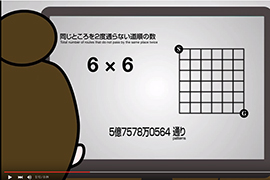Exploratory Research for Advanced Technology (ERATO) Research Funding Program
http://www.jst.go.jp/erato/en/index.html
National Museum of Emerging Science and Innovation (Miraikan)
http://www.miraikan.jst.go.jp/en/
Have you ever watched the popular animation—“Time with Class! Let’s Count!”—which boasts over 1.75 million views on YouTube? The animated character “teacher” has appeared as stickers produced by LINE (a mobile messenger application).
The animation was created for the exhibition, “The Art of 1064 – Understanding Vastness,” which was held in 2012 at the National Museum of Emerging Science and Innovation (Miraikan). The exhibition was developed to disseminate the research results derived from the JST ERATO MINATO Discrete Structure Manipulation System Project (Research Director: Dr. MINATO Shin-ichi, Professor at the Graduate School, Hokkaido University).
The more ways we count, the bigger the combinations of things we obtain become, including coupon tickets and train connections. We refer to these as “combinatorial explosions”. Counting the methods of combining in a simple way is extremely time-consuming. However, we just might be able to obtain the combinations hundreds or thousands of time faster using the algorithm techniques developed by Dr. MINATO and others. Furthermore, indexing the combinations we’ve obtained allows us to quickly select only the ones we need. For instance, by adding a city’s population and the conditions of the neighboring municipalities to combinations of the electoral districts, we’re able to arrange them according to the disparity in the relative weight of one vote.
The animation, which illustrates the teacher’s passion for demonstrating how amazing the combinatorial explosions are, has evoked a massive response both domestically and abroad. The video has been used in classes at universities and high schools as educational material that explains in a simple way just how important algorithm is. After watching the video, some students have become interested in algorithms and participated in Dr. MINATO’s laboratory.
The LINE sticker was created following a special class at Hokkaido University in the fall of 2013 and the participating students were from Ritsumeikan Keisho Junior & Senior High School, which the Ministry of Education, Culture, Sports, Science and Technology (MEXT) has designated as a super science high school (SSH). “I was asked by one female student, ‘Are you planning to launch LINE stickers of the teacher?’ ” says Dr. MINATO. “Many other students also expressed their interest in using the stickers if they’re launched. Since I had to go through a number of procedures such as acquisition of intellectual property rights, I was close to giving up halfway through, but continued to make an effort to ensure the stickers would be launched for those students.
LINE is a global communication tool with over 500 million users. If the stickers are widely used, the algorithm techniques originating in Japan will also draw global attention.
- - This is an English translation of NEWS 2 in TOPICS, which was published in the December 2015 issue of JST news.
http://www.jst.go.jp/pr/jst-news/pdf/2015/2015_12_p14.pdf

It took 250,000 years to calculate the combinations with the super computer the teacher used, but it is possible to do that instantly using algorithm techniques developed by Dr. MINATO.

There are 40 types of “Combinatorial Explosion!” stickers available.
The teacher starts a class of “How to count combinations.” (Left)
The more squares there are, the longer it takes to calculate. The teacher and children have a sleepover when the box is divided into 9 squares by 9 squares. (Center)
What happened to the teacher when the box was divided into 10 squares x 10 squares? (Right)
JST, an integrated organization of science and technology in Japan, establishes an infrastructure for the entire process from the creation of knowledge to the return to the society. For more information, visit http://www.jst.go.jp/EN/